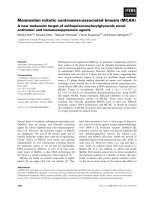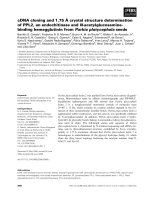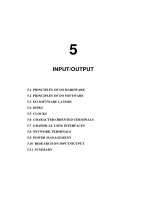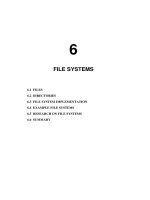A computer system consists of hardware, system programs, and application programs figs 6
Bạn đang xem bản rút gọn của tài liệu. Xem và tải ngay bản đầy đủ của tài liệu tại đây (404.58 KB, 40 trang )
6
FILE SYSTEMS
6.1 FILES
6.2 DIRECTORIES
6.3 FILE SYSTEM IMPLEMENTATION
6.4 EXAMPLE FILE SYSTEMS
6.5 RESEARCH ON FILE SYSTEMS
6.6 SUMMARY
Extension Meaning
file.bak Backup file
file.c C source program
file.gif Compuserve Graphical Interchange Format image
file.hlp Help file
file.html World Wide Web HyperText Markup Language document
file.jpg Still picture encoded with the JPEG standard
file.mp3 Music encoded in MPEG layer 3 audio format
file.mpg Movie encoded with the MPEG standard
file.o Object file (compiler output, not yet linked)
file.pdf Portable Document Format file
file.ps PostScript file
file.tex Input for the TEX formatting program
file.txt General text file
file.zip Compressed archive
Fig. 6-1. Some typical file extensions.
(a) (b) (c)
1 Record
Ant Fox Pig
Cat Cow Dog Goat Lion Owl Pony Rat Worm
Hen Ibis Lamb
1 Byte
Fig. 6-2. Three kinds of files. (a) Byte sequence. (b) Record
sequence. (c) Tree.
(a) (b)
Header
Header
Header
Magic number
Text size
Data size
BSS size
Symbol table size
Entry point
Flags
Text
Data
Relocation
bits
Symbol
table
Object
module
Object
module
Object
module
Module
name
Date
Owner
Protection
Size
Header
Fig. 6-3. (a) An executable file. (b) An archive.
Attribute Meaning
Protection Who can access the file and in what way
Password Password needed to access the file
Creator ID of the person who created the file
Owner Current owner
Read-only flag 0 for read/write; 1 for read only
Hidden flag 0 for normal; 1 for do not display in listings
System flag 0 for normal files; 1 for system file
Archive flag 0 for has been backed up; 1 for needs to be backed up
ASCII/binary flag 0 for ASCII file; 1 for binary file
Random access flag 0 for sequential access only; 1 for random access
Temporary flag 0 for normal; 1 for delete file on process exit
Lock flags 0 for unlocked; nonzero for locked
Record length Number of bytes in a record
Key position Offset of the key within each record
Key length Number of bytes in the key field
Creation time Date and time the file was created
Time of last access Date and time the file was last accessed
Time of last change Date and time the file has last changed
Current size Number of bytes in the file
Maximum size Number of bytes the file may grow to
Fig. 6-4. Some possible file attributes.
/
*
File copy program. Error checking and reporting is minimal.
*
/
#include <sys/types.h> /
*
include necessary header files
*
/
#include <fcntl.h>
#include <stdlib.h>
#include <unistd.h>
int main(int argc, char
*
argv[]); /
*
ANSI prototype
*
/
#define BUF SIZE 4096 /
*
use a buffer size of 4096 bytes
*
/
#define OUTPUT MODE 0700 /
*
protection bits for output file
*
/
int main(int argc, char
*
argv[])
{
int in fd, out fd, rd count, wt count;
char buffer[BUF SIZE];
if (argc != 3) exit(1); /
*
syntax error if argc is not 3
*
/
/
*
Open the input file and create the output file
*
/
in fd = open(argv[1], O RDONLY); /
*
open the source file
*
/
if (in fd < 0) exit(2); /
*
if it cannot be opened, exit
*
/
out fd = creat(argv[2], OUTPUT MODE); /
*
create the destination file
*
/
if (out fd < 0) exit(3); /
*
if it cannot be created, exit
*
/
/
*
Copy loop
*
/
while (TRUE) {
rd count = read(in fd, buffer, BUF SIZE); /
*
read a block of data
*
/
if (rd count <= 0) break; /
*
if end of file or error, exit loop
*
/
wt count = write(out fd, buffer, rd count); /
*
write data
*
/
if (wt count <= 0) exit(4); /
*
wt count <= 0 is an error
*
/
}
/
*
Close the files
*
/
close(in fd);
close(out fd);
if (rd count == 0) /
*
no error on last read
*
/
exit(0);
else
exit(5); /
*
error on last read
*
/
}
Fig. 6-5. A simple program to copy a file.
Data
(a)
Program
text
Program
text
abc
xyz
Data
(b)
Fig. 6-6. (a) A segmented process before mapping files into its
address space. (b) The process after mapping an existing file abc
into one segment and creating a new segment for file xyz.
Root directory
A A B C
Fig. 6-7. A single-level directory system containing four files,
owned by three different people, A, B, and C.
Files
User
directory
A A
AB
B
C
CCC
Root directory
Fig. 6-8. A two-level directory system. The letters indicate the
owners of the directories and files.
User
directory
User subdirectories
C C
C
C C
C
B
B
A
A
B
B
C C
C
B
Root directory
User file
Fig. 6-9. A hierarchical directory system.
Root directory
bin etc lib usr
ast
jim
tmp
jim
bin
etc
lib
usr
tmp
/
ast
/usr/jim
lib
lib
dict.
Fig. 6-10. A UNIX directory tree.
Entire disk
Disk partition
Partition table
Files and directoriesRoot dirI-nodesSuper block Free space mgmtBoot block
MBR
Fig. 6-11. A possible file system layout.
…
File A
(4 blocks)
File C
(6 blocks)
File B
(3 blocks)
File D
(5 blocks)
File F
(6 blocks)
File E
(12 blocks)
File G
(3 blocks)
(a)
…
(File A) (File C)
File B
5 Free blocks 6 Free blocks
(File E) (File G)
(b)
Fig. 6-12. (a) Contiguous allocation of disk space for seven files.
(b) The state of the disk after files D and F have been removed.
File A
Physical
block
Physical
block
4
0
7 2 10 12
File
block
0
File
block
1
File
block
2
File
block
3
File
block
4
File B
0
631114
File
block
0
File
block
1
File
block
2
File
block
3
Fig. 6-13. Storing a file as a linked list of disk blocks.
Physical
block
File A starts here
File B starts here
Unused block
0
1
2
3
4
5
6
7
8
9
10
11
12
13
14
15
10
11
7
3
2
12
14
-1
-1
Fig. 6-14. Linked list allocation using a file allocation table in
main memory.
File Attributes
Address of disk block 0
Address of disk block 1
Address of disk block 2
Address of disk block 3
Address of disk block 4
Address of disk block 5
Address of disk block 6
Address of disk block 7
Address of block of pointers
Disk block
containing
additional
disk addresses
Fig. 6-15. An example i-node.
(a)
games
news
work
attributes
attributes
attributes
attributes
Data structure
containing the
attributes
(b)
games
news
work
Fig. 6-16. (a) A simple directory containing fixed-size entries with
the disk addresses and attributes in the directory entry. (b) A direc-
tory in which each entry just refers to an i-node.
File 1 entry length
File 1 attributes
Pointer to file 1's name
File 1 attributes
Pointer to file 2's name
File 2 attributes
Pointer to file 3's name
File 2 entry length
File 2 attributes
File 3 entry length
File 3 attributes
p
e
b
e
r
c
u
t
o
t
d
j
-
g
p
e
b
e
r
c
u
t
o
t
d
j
-
g
p
e
r
s
o
n
n
e
l
f
o
o
p
o
l
e
n
r
n
foo
s
e
Entry
for one
file
Heap
Entry
for one
file
(a) (b)
File 3 attributes
Fig. 6-17. Two ways of handling long file names in a directory.
(a) In-line. (b) In a heap.
Root directory
B
B B C
C C
CA
B
C
B
? C C C
A
Shared file
Fig. 6-18. File system containing a shared file.
C's directory B's directory B's directoryC's directory
Owner = C
Count = 1
Owner = C
Count = 2
Owner = C
Count = 1
(a) (b) (c)
Fig. 6-19. (a) Situation prior to linking. (b) After the link is
created. (c) After the original owner removes the file.
1000
800
600
400
200
0 0
1000
80
60
40
20
1280 0256 512 1K 2K 4K 8K 16K
Disk space utilization
(percent)
Data rate (KB/sec)
Disk space utilization
Data rate
Block size (bytes)
Fig. 6-20. The solid curve (left-hand scale) gives the data rate of a
disk. The dashed curve (right-hand scale) gives the disk space
efficiency. All files are 2 KB.
(a) (b)
Free disk blocks: 16, 17, 18
A bitmapA 1-KB disk block can hold 256
32-bit disk block numbers
86
234
897
422
140
223
223
160
126
142
141
1001101101101100
0110110111110111
1010110110110110
0110110110111011
1110111011101111
1101101010001111
0000111011010111
1011101101101111
1100100011101111
0111011101110111
1101111101110111
230
162
612
342
214
160
664
216
320
180
482
42
136
210
97
41
63
21
48
262
310
516
Fig. 6-21. (a) Storing the free list on a linked list. (b) A bitmap.
(a)
Disk
Main
memory
(b) (c)
Fig. 6-22. (a) An almost-full block of pointers to free disk blocks
in memory and three blocks of pointers on disk. (b) Result of free-
ing a three-block file. (c) An alternative strategy for handling the
three free blocks. The shaded entries represent pointers to free disk
blocks.
Open file table Quota table
Soft block limit
Hard block limit
Current # of blocks
# Block warnings left
Soft file limit
Hard file limit
Current # of files
# File warnings left
Attributes
disk addresses
User = 8
Quota pointer
Quota
record
for user 8
Fig. 6-23. Quotas are kept track of on a per-user basis in a quota
table.
1
18
19
5
6
27
7 10
20 22
30
29
23
1411
2
3 4
8 9
12 13 15
31
28
32
24 25 26
16
17
21
File that
has changed
File that has
not changed
Root directory
Directory
that has not
changed
Fig. 6-24. A file system to be dumped. The squares are directories
and the circles are files. The shaded items have been modified
since the last dump. Each directory and file is labeled by its i-
node number.









